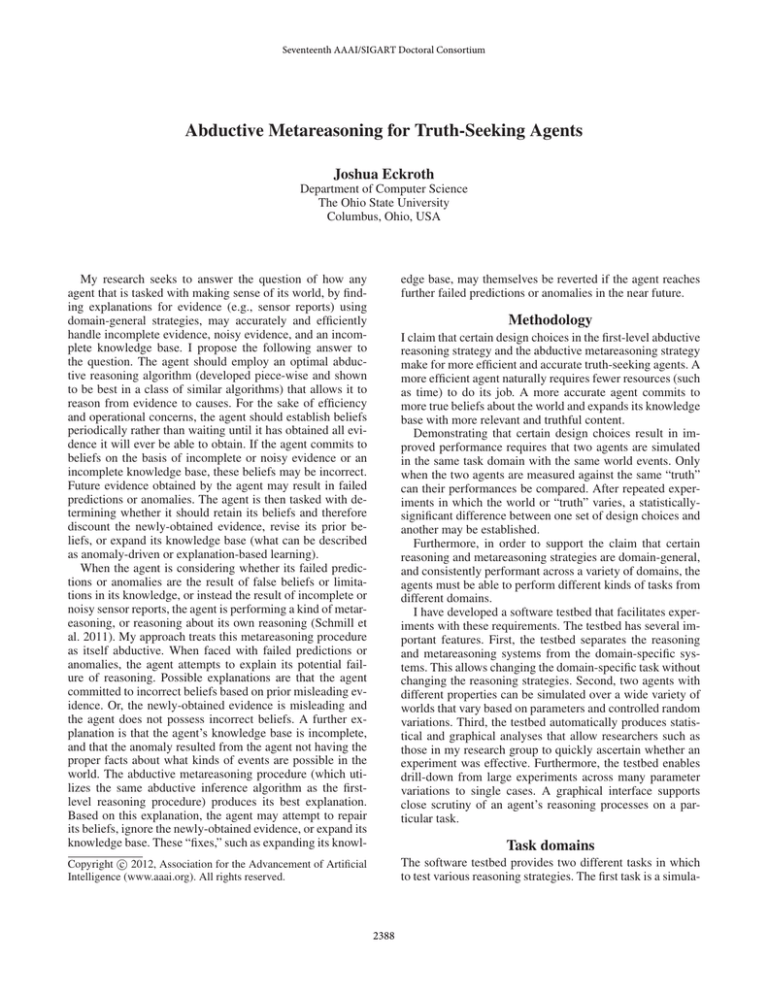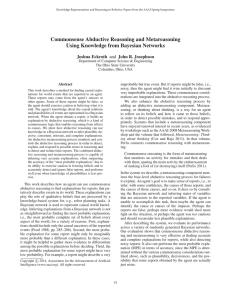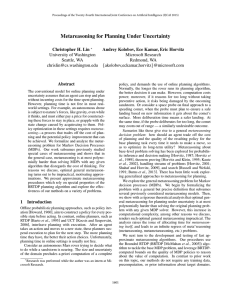
Seventeenth AAAI/SIGART Doctoral Consortium
Abductive Metareasoning for Truth-Seeking Agents
Joshua Eckroth
Department of Computer Science
The Ohio State University
Columbus, Ohio, USA
My research seeks to answer the question of how any
agent that is tasked with making sense of its world, by finding explanations for evidence (e.g., sensor reports) using
domain-general strategies, may accurately and efficiently
handle incomplete evidence, noisy evidence, and an incomplete knowledge base. I propose the following answer to
the question. The agent should employ an optimal abductive reasoning algorithm (developed piece-wise and shown
to be best in a class of similar algorithms) that allows it to
reason from evidence to causes. For the sake of efficiency
and operational concerns, the agent should establish beliefs
periodically rather than waiting until it has obtained all evidence it will ever be able to obtain. If the agent commits to
beliefs on the basis of incomplete or noisy evidence or an
incomplete knowledge base, these beliefs may be incorrect.
Future evidence obtained by the agent may result in failed
predictions or anomalies. The agent is then tasked with determining whether it should retain its beliefs and therefore
discount the newly-obtained evidence, revise its prior beliefs, or expand its knowledge base (what can be described
as anomaly-driven or explanation-based learning).
When the agent is considering whether its failed predictions or anomalies are the result of false beliefs or limitations in its knowledge, or instead the result of incomplete or
noisy sensor reports, the agent is performing a kind of metareasoning, or reasoning about its own reasoning (Schmill et
al. 2011). My approach treats this metareasoning procedure
as itself abductive. When faced with failed predictions or
anomalies, the agent attempts to explain its potential failure of reasoning. Possible explanations are that the agent
committed to incorrect beliefs based on prior misleading evidence. Or, the newly-obtained evidence is misleading and
the agent does not possess incorrect beliefs. A further explanation is that the agent’s knowledge base is incomplete,
and that the anomaly resulted from the agent not having the
proper facts about what kinds of events are possible in the
world. The abductive metareasoning procedure (which utilizes the same abductive inference algorithm as the firstlevel reasoning procedure) produces its best explanation.
Based on this explanation, the agent may attempt to repair
its beliefs, ignore the newly-obtained evidence, or expand its
knowledge base. These “fixes,” such as expanding its knowl-
edge base, may themselves be reverted if the agent reaches
further failed predictions or anomalies in the near future.
c 2012, Association for the Advancement of Artificial
Copyright Intelligence (www.aaai.org). All rights reserved.
The software testbed provides two different tasks in which
to test various reasoning strategies. The first task is a simula-
Methodology
I claim that certain design choices in the first-level abductive
reasoning strategy and the abductive metareasoning strategy
make for more efficient and accurate truth-seeking agents. A
more efficient agent naturally requires fewer resources (such
as time) to do its job. A more accurate agent commits to
more true beliefs about the world and expands its knowledge
base with more relevant and truthful content.
Demonstrating that certain design choices result in improved performance requires that two agents are simulated
in the same task domain with the same world events. Only
when the two agents are measured against the same “truth”
can their performances be compared. After repeated experiments in which the world or “truth” varies, a statisticallysignificant difference between one set of design choices and
another may be established.
Furthermore, in order to support the claim that certain
reasoning and metareasoning strategies are domain-general,
and consistently performant across a variety of domains, the
agents must be able to perform different kinds of tasks from
different domains.
I have developed a software testbed that facilitates experiments with these requirements. The testbed has several important features. First, the testbed separates the reasoning
and metareasoning systems from the domain-specific systems. This allows changing the domain-specific task without
changing the reasoning strategies. Second, two agents with
different properties can be simulated over a wide variety of
worlds that vary based on parameters and controlled random
variations. Third, the testbed automatically produces statistical and graphical analyses that allow researchers such as
those in my research group to quickly ascertain whether an
experiment was effective. Furthermore, the testbed enables
drill-down from large experiments across many parameter
variations to single cases. A graphical interface supports
close scrutiny of an agent’s reasoning processes on a particular task.
Task domains
2388
Proposed timeline (to July 2012)
tion of video surveillance. Entities (which all have the same
shape but may differ in color) move somewhat randomly
throughout a space that is observed by simulated video sensors. Some sensors are able to report the colors of entities,
others are not (entities observed by these sensors appear
gray). The agent’s goal is to keep track of the various entities and maintain their identities. This task becomes more
difficult as the number of entities in the scene increases and
fewer sensors are able to detect color. Lack of color in sensor
reports causes the agent to have access to incomplete information about the world.
The second task is Chinese word segmentation. The agent
reads a sequence of Chinese characters; these characters are
not segmented into words (the spaces have been removed
from the test data). The goal is to segment the characters
into words, based on knowledge about Chinese word frequencies, word transitions, and so on. Noise is simulated
in this domain by swapping a random subset of the characters to other random characters. Some of the words are
“out-of-vocabulary” words, meaning they were not present
in the training set that the agent used to build its knowledge
base. Thus, some words may need to be learned. Incomplete
information is also possible because the agent does not always receive a complete sequence of characters, but only
a subset, which may contain portions of true words. The
task becomes more difficult as noise increases, the agent’s
knowledge base is more limited (which produces more outof-vocabulary words in the test data), and smaller subsets of
the character sequence are available.
The video surveillance domain tests agents on their ability
to handle incomplete information. The Chinese word segmentation domain tests agents on their ability to handle incomplete information, limited knowledge, and noise, and
any combination of these factors.
My candidacy examination will be scheduled for early Summer. After this time, I will document and seek publication of
results relating to the Chinese word segmentation task.
Individual contributions
All of the software implementation and experiments have
been my own. The abductive inference strategy that these
agents utilize is a modification of a strategy developed by
my advisor (Josephson 2000).
References
Emerson, T. 2005. The second international chinese
word segmentation bakeoff. In Proceedings of the Fourth
SIGHAN Workshop on Chinese Language Processing, volume 133. Jeju Island, Korea.
Josephson, J. R. 2000. On the proof dynamics of inference
to the best explanation. Cardozo Law Review 22:1621–1643.
Reprinted in MacCrimmon, M. T. and Tillers, P., eds. 2002.
The Dynamics of Judicial Proof: Computation, Logic, and
Common Sense. Physica-Verlag. 287–306.
Kruengkrai, C.; Uchimoto, K.; Kazama, J.; Wang, Y.; Torisawa, K.; and Isahara, H. 2009. An error-driven wordcharacter hybrid model for joint chinese word segmentation
and pos tagging. In Proceedings of the Joint Conference of
the 47th Annual Meeting of the ACL and the 4th International Joint Conference on Natural Language Processing of
the AFNLP, 513–521. Association for Computational Linguistics.
Schmill, M. D.; Anderson, M. L.; Fults, S.; Josyula, D.;
Oates, T.; Perlis, D.; Shahri, H.; Wilson, S.; and Wright, D.
2011. The metacognitive loop and reasoning about anomalies. In Cox, M. T., and Raja, A., eds., Metareasoning:
Thinking about Thinking. The MIT Press. chapter 12, 183–
200.
Zhao, H.; Huang, C. N.; and Li, M. 2006. An improved
chinese word segmentation system with conditional random
field. In Proceedings of the Fifth SIGHAN Workshop on Chinese Language Processing, volume 1082117. Sydney: July.
Preliminary results (as of April 2012)
The first-level abductive reasoning process, with no metareasoning facility, has proven to be effective. In both task domains, agents achieve relatively high precision and recall. Fscores for the Chinese word segmentation task are presently
around 0.94, while the state-of-the-art scores, on the same
datasets, are about 0.97 (Zhao, Huang, and Li 2006; Emerson 2005). The video surveillance domain is synthetic and
thus difficult to compare to other systems. However, I have
reason to believe the first-level abductive reasoning process
is sufficiently capable and implemented properly.
The abductive metareasoning process is still undergoing
considerable development. I have tested its ability to correct mistaken prior beliefs by reconsidering past evidence
in light of new evidence, and its ability to invoke learning.
Experiments indicate that the belief correction strategy increases accuracy but also increases resource usage because
prior evidence is being reconsidered. Learning as a “fix” for
anomalies appears to be working as well, although not to
a degree that matches the state-of-the-art. In the Chinese
word segmentation domain, my software is achieving outof-vocabulary recall rates of about 0.35 (for the same Fscore cited above) while the recent state-of-the-art achieves
0.77 out-of-vocabulary recall (Kruengkrai et al. 2009).
2389





